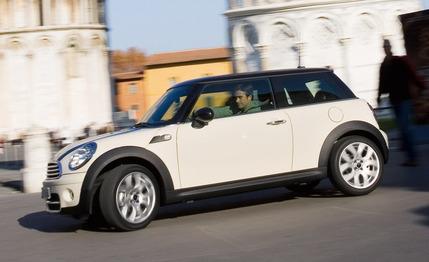 Short Take Road Test
Short Take Road Test
You always want what you can’t have. When a diesel-sipping Mini showed up in our back lot, we thought, Cool, another European model that probably won’t ever come here, packing fuel-saving tech that—if you ask our lawmakers—no one wants. It was at about that time, however, that reports began circulating of the possible importation of said diesel vehicle to the U.S. Would we still want it if we could have it?
Throw a D on It

The Cooper D looks like the hardtop Cooper we’re used to, except there’s a “D” badge on the back. Our tester had “Bosch Clean Diesel” stickers, too, further alerting passersby to what was in the tank. The Cooper D is powered by a 1.6-liter Peugeot-supplied four-cylinder turbo-diesel that uses a variable-geometry turbocharger and common-rail fuel injection. It spits out particulate-filter-scrubbed exhaust. According to Mini, a U.S.-market Cooper D would need a different engine, as the current car cannot meet our strict emissions regulations for oxides of nitrogen.
Although the diesel makes the same amount of torque as the turbocharged Mini Cooper S—both 1.6-liter engines make a maximum of 192 lb-ft when in overboost mode—the diesel manages to translate its thrust to forward motion in a more pleasing manner. Both engines hit their torque peak near the same point in the rev range, but the difference is that the Cooper D builds twist smoothly, whereas the Cooper S tries to rip the wheel from your hands and sublimate the tires, all while the traction-control light works overtime. The diesel’s trade-off, of course, is a lack of power. With 107 hp, the D is less powerful than a non-S Cooper’s naturally aspirated four-cylinder, and the oil burner runs out of steam near redline. It also loses stoplight drags to the base Cooper, needing 8.9 seconds versus 7.7 to reach 60 mph. The Cooper S, of course, leaves both cars in a cloud of fine, rubbery dust.
A Healthy Economy

Like the rest of the Mini lineup, the Cooper D has a standard six-speed manual, but in this case it’s geared for fuel economy. Like other Minis, this one is a blast to heel-and-toe shift, a privilege we’re almost never afforded with other U.S.-market diesel engines, fitted as most of them are to autobox-havin’ big trucks and SUVs. Flog as we did, the little Germanic-bred Brit still managed an impressive average of 41 mpg over the duration of our two-week test—all while delivering the sporty and fun driving experience we’re used to in gas-fired versions. For comparison, the regular Cooper has achieved 30 mpg in our tests, whereas a Cooper S returned a dismal 23 mpg.
To help achieve something close to those figures, the D car provides specific fuel-efficiency instructions. The small display in the tachometer indicates not only when it’s economical to up- or downshift but also precisely which of the six ratios to choose when doing so. We aren’t used to shifting before reaching 35 mph, let alone to fifth gear, but we got used to it.
It Starts Stopping When It Stops Stopping
Further aiding us in the pursuit of frugal low fuel consumption was an aggressive engine-shutdown system. Although many vehicles will deactivate a portion of the engine’s cylinders when they’re not needed—Chrysler’s 5.7-liter Hemi offers the technology—the Cooper D silences all four cylinders when stopped, similar to a hybrid. Slowing to a stop, the engine will shut itself off with a pronounced shudder once your speed is below 2 mph, the transmission is in neutral, and your foot is off the clutch. Clutch in, and the engine will light back up—just be sure to stay alert, because it takes a second to fire and become usable again. BMW includes an auto start/stop system on many of its European offerings, but we’ve been told in the past not to expect this feature to cross the pond, since a car’s EPA test numbers would show little improvement, a payoff that doesn’t warrant the added expense of a more stout battery and alternator.
It’s tough to nail down a potential U.S. price for this car, especially since there would be some extra cost involved in creating a new 50-state-legal diesel engine. Going by prices for the current European Cooper lineup, where the D slots in nicely between the base and S cars, we would expect a price of about $21,000.
Whereas Audi, BMW, and Mercedes-Benz have focused their diesel efforts on the luxury end to hide the extra cost of a diesel powerplant, only Volkswagen so far has delivered an affordable diesel with the Jetta TDI. Its lower price has made the Jetta TDI a sort of cult hit in America, and we think this Mini could achieve a similar status. We often long most for that which is unattainable, but the Cooper D is entertaining and frugal enough that we think our yearning will endure past a possible U.S. debut. Hey, Mini, get it over here quick, okay?